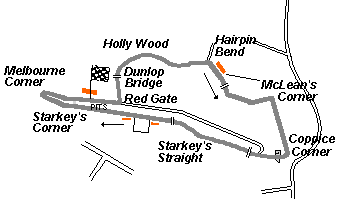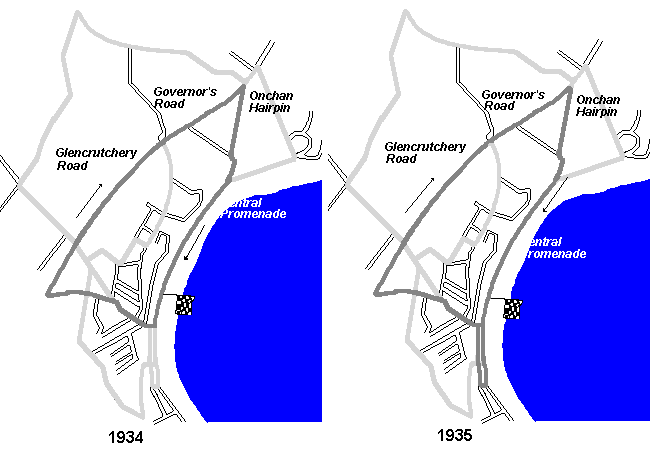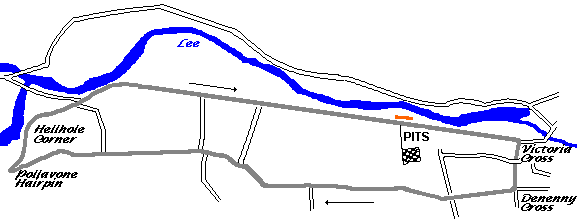BROOKLANDS (GB)
Type: Autodrome Length: 4.453 km / 2.767 Miles (Circle) 1.883 km / 1.170 Miles (Mountain) 3.648 km / 2.267 Miles (Campbell) Location: Brooklands estate near Weybridge, Surrey, 32 km SW of London Used: 1907 - 1939 The Brooklands circuit was the first purpose built circuit in Europe. It came about from an idea of Hugh Fortesque Locke King who himself invested £150000 and it was designed by Colonel Holden and opened on 17th June 1907. Because there were no earlier tracks as a model, the design was based on horse racing. The track thus became oval shaped with a special finishing straight. The track was 100 ft (30.4m) wide and the surface consisted of a flimsy 6´ (15 cm) layer of concrete. Even with extensive repairs the track eventually became very bumpy. The Byfleet Banking had a mean radius of 1550 feet and had a super elevation of 17' (5.2m) giving a mean inclination of 9.5° and an inclination of 25.2° at the top. The curve fell away before crossing the river Way on a ferro-concrete bridge (revolutionary in its day) and reached the Fork, where the left branch led to the Finishing Straight and the right branch passed the Italia works (Later Vickers) in a reverse curve before climbing to the Home or Members banking. The Members Banking had a mean radius of 1000 feet and had a super elevation of 32' giving it a mean inclination of 17.7° and an inclination of 26.5° at the top. The Finishing Straight went upward in an angle of about 5° to connect to the Members banking. The Members Banking was continued by the half mile Railway Straight that followed the railway embankment. Total length including Finishing Straight was 3 1/4 Miles. A lap on the 50-ft line measured 2 Miles 1349.7 yards (4452.9 m). The Brooklands remained a world of its own, separated from other kinds of motor racing. It was extensively used for testing and record attempts as well as handicap racing. Without going too far into details the races were divided into Long Handicaps (3 laps + finishing straight, ca. 8.5 mi) and Short Handicaps (2 laps + finishing straight, ca. 5.75 mi). In 1930 five laps Mountain handicap races were added to the list. Before 1930 there were 75 mph, 90 mph, 100 mph and Lightning classes of handicap races and after that Junior, Senior and Lightning classes. So races could be "Lightning Long Handicap", "90 mph Short Handicap" etc., each race individually numbered. After 1930 races got individual names instead of running numbers. There were several finish lines on the Finishing Straight. There was a "Long" finishing line at the Judges box, 50 yards before that line there was a "Short" finishing line indicated by two red discs, 200 yards further back there was a "Special Short" line and finally another 100 yards towards the Fork there was a "Lightning" finishing line. In 1924 as speeds increased and it became difficult for cars to pull up in the Finishing Straight the Lightning class finish line was moved to the Railway Straight. In the first years identification was supposed to be by colors worn by the drivers. Soon the organizers were reluctantly forced to change it to car numbers instead but driver colors partly remained in use until the First World War. In the 1930s a system was introduced for some races in which instead of sending away the cars according to handicap all cars were divided into four classes which had to race through chicanes of different nature and length in the Fork Bend, depending on class. Cars were color coded in tail showing which chicane it should use. In 1937 in an effort to compete with the new British racing circuits the more GP like Campbell Circuit was added. In 1926 and 1927 the track (with extra straw bale chicanes) held the British GPs. Brooklands also became famous for its monster car speed attempts like Count Zborowski's Chitty-Bang-Bang and John Cobb's Napier-Railton. At the outbreak of the Second World War the track was taken over by Vickers-Armstrong and in 1946 the track was sold to the company for £ 300000. Special Circuit: 1926 BRITISH GRAND PRIXOuter Circuit: 1932 BRITISH EMPIRE TROPHYMountain Circuit: 1931 MOUNTAIN CHAMPIONSHIPCampbell Circuit: 1937 CAMPBELL TROPHYB.A.R.C. Club races:
J.C.C. Club races:
500 Mile races:
DONINGTON PARK (GB)
Type: Park circuit Length: 3.518 km / 2.186 miles (1933), 4.107 km / 2.552 miles (1934 - 37), 5.029 km / 3.125 miles (1937 onwards) Location: Between Derby and Leicester, England Used: 1931-1939, 1977- The Donington Park GP circuit was the result of an effort of Fred Craner. He was a former motorcycle driver who had taken part in seven Isle of Man TTs. As the energetic secretary of the Derby & District Motor Club he had seen the opportunity and he then took the motorcycle grass course of the club to the very top. The track was situated in East Midlands, ten miles southeast of Derby, in Mr. J.G. Shields' park near the 17th century Donington Hall. Motorcycle racing had started there in 1931. In 1933 Craner had obtained permission to build a permanent 2 mile 327 yards (3.518 km) tarmac track on some of the park roads and car racing began with four meetings held in that first year. The following year the length of the track was increased to 2 mile 971 yards (4.107 km). The Nuffield Trophy became a yearly handicap event in the British calendar. The impressive Donington Hall with its 80 bedrooms, that had fallen into disrepair and among other things served as a camp for German prisoners of war during WW1, was restored and became a fitting hotel and clubhouse. In 1935 the first Donington Grand Prix was held, the first ever Grand Prix held in Britain on a road track (The RAC refused Craner to use the term "British Grand Prix"), Shuttleworth (Alfa Romeo) winning the race. Donington had by now replaced Brooklands as the most important track in England and as to show it the British Empire Trophy was moved from Brooklands to Donington in 1936. The 1936 Donington Grand Prix was won by Hans Rüesch, who shared his Alfa Romeo with Dick Seaman. But bigger things were to come. After the catastrophic 1936 Tourist Trophy, the decision was taken by RAC to move further races from the Ards circuit in Ireland and even if several Irish tracks were considered it was finally Fred Craner who came out on top after having promised several alterations to the Donington track. At about the same time Craner also managed to convince Daimler-Benz to take part in the Grand Prix. Later Auto Union also decided to enter their cars and the event changed its nature from a mere Mercedes-Benz demonstration run into a Grande Epreuve. As soon as Craner got the final announcement from RAC, work on the alterations necessary for the Tourist Trophy started. The track had to be widened in several places, trees had to be removed and spectator areas had to be opened. The main straight had to be lengthened to enable the sports cars to reach top speed, thus increasing the length of the track to 3 mile 220 yards (5.029 km). New run off areas were added as was parking for 6000 cars. The grandstand was enlarged and a totally new pit complex was built. The first corner after the start line was the Red Gate, not a right-hander as nowadays but a tight left-hander. The track continued under the Dunlop bridge and into Holly Wood. From there it went downhill, passing the Donington Hall down to Hairpin Bend that wasn't a hairpin bend in modern Grand Prix racing sense, and passed under a stone wall through a narrow gate. A series of left-handers took the cars upwards to McLean's Corner. Then the track continued through Coppice Wood to Coppice Corner and the Coppice Farm, where the track passed between the farm houses and sheds! The long Starkey's Straight was next and it ended in a steep downhill, just at the place where the cars had to brake for the new Melbourne Corner, a hairpin named after a nearby village. The new track was ready for the 1937 TT run on September 4th where Comotti won for Darracq (Talbot). The Donington GP was run a month later and won by Bernd Rosemeyer (Auto Union). The German GP cars were back a year later and after a delay because of the political situation the GP took place after all, three weeks after the original date, winner being Tazio Nuvolari. Racing went on at the track until the start of the Second World War. The land was bought by Tom Wheatcroft in 1971 and the track was re-opened in 1977. Tom Wheatcroft's greatest moment came in 1993 when the track held the European Grand Prix that proved to be a classic event won by Ayrton Senna (McLaren). 4.107 km circuit: 1933 DONINGTON PARK TROPHY5.029 km circuit: 1937 RAC TOURIST TROPHY (Sports car) CRYSTAL PALACE - London (GB)
Type: Park circuit Length: 3.2 km / 2 Miles Location: Anerly Hill, Sydenham, South London Used: 1937-1939, 1953-1972 The famous Crystal Palace was built in Hyde Park, London, for the Great Exhibition of 1851, an event conceived to symbolize the industrial, military and economic superiority of Great Britain. Designed by Sir Joseph Paxton and taking advantage of the latest technological achievements, this remarkable glass and steel construction, the largest of its kind ever constructed, measured 1,848 feet (563 m) in length, 408 feet (124 m) in width and 108 feet (33 m) in height. The floor area was about 990,000 square feet (92,000 m²) and there were more than 8 miles (13 km) of display tables on the floor and galleries. Between 1 May and 11 October 1851 more than six million visitors attended the Great Exhibition. Thereafter the Crystal Palace was taken apart and then reassembled in a park at Sydenham Hill, south of London. For many years the Crystal Palace became the site of shows, exhibitions, circus, concerts, football matches, and other entertainment. Motor racing started at Crystal Palace on 21 May 1927 when a motorcycle race was held on a one mile course in the park. A speedway track was built in the football stadium and used between 1928 and 1934. In 1935 plans were made for building a two mile Grand Prix track in the park. Then, on 30th November 1936, Crystal Palace was destroyed by fire. It was in fact a turning point for the park and after that the area lost much of its focus and began to decline. The remains of the towers were demolished in 1941 because they were potential landmarks for the German bombers. In early December 1936, only three days after the fire, work began on a Grand Prix track with a new "Panamac" non-skid surface. Called a "miniature Nürburgring" by the British motor press the twisty circuit was completed in 5 months and the first event, the Coronation Trophy, was held on 24 April 1937, the event being won by Fairfield (ERA). Then both cycles and motor cycles had competitions on the track before car racing was back on 17 July with the London Grand Prix, in which "B Bira" took the victory in his ERA. The International Imperial Trophy Race won by "B Bira" was significant as it was to be televised by the BBC, the first ever live TV outside broadcast of motor sport. Between the heats Seaman demonstrated the Mercedes-Benz W125. Racing continued on Crystal Palace until the war, the last pre-war event being held on 26th August 1939. In 1953 international racing resumed on a rebuilt shortened track and went on until 1972 when nice objections and safety concerns forced the track to be closed. 1937 CORONATION TROPHY (Voiturette) DOUGLAS - Isle of Man (GBM)

Type: Street Circuit Length: 1934: 5.96 km / 3.7 Miles 1935: 6.5 km / 4.04 Miles 1936: 6.44 km / 4.0 Miles 1937: 6.26 km / 3.89 Miles Location: Central Douglas, Isle Of Man Used: 1933 - ? 1933 MANNIN MOAR ARDS - Belfast (GB)
Type: Road course Length: 22 km (13.67 Miles) Location: South-east of Belfast Used: 1928-1936 The Tourist Trophy had been run at the Isle of Man before the First World War. In 1922 Harry Ferguson and Wallace McLeod managed to get the TT to the Ards track south-east of Belfast. The project was possible because of the fact that unlike in the rest of the United Kingdom the law in Ulster permitted roads to be closed off for motor racing. The circuit was circular shaped and went between the towns of Dundonald, Newtownards and Comber. The start was at the Newtownards Road 1 1/2 miles from Dundonald and 300m from the left hand Quarry Corner. The track continued towards Newtownards via Quarry Corner, then up Mill Hill and to Cree's Corner at the top of Bradshaw's Brae and then downhill, including seven bends within half a mile, leading to a railway bridge into Newtownards where it passed the Town Hall at the end of Regent Street and continued into Conway Square and from there to South Street. From there the track led, via its fastest sections, towards Comber, passing the aerodrome at Strangford Lough and going through a S-bend and over a level crossing into the town. There it made a 90 degree right hand turn around McWhinney's butcher shop and followed along the Ballystockart Road past the farm to Dundonald, where a hairpin led it back to the start section. Parts of the course were extremely narrow making passing almost impossible and visibility was also bad along several sections because of tall banks bordering the road. The track also crossed the railroad at a level crossing once and three times on bridges. The first Ulster TT was run in 1928 as a sports car handicap and was won by Kaye Don in a Lea Francis. Next year Rudi Caracciola dominated the event in rainy conditions in his big Mercedes-Benz SS and the year after that it was Nuvolari's turn for Alfa Romeo. By then the TT had proved highly popular with spectators counted in hundreds of thousands. Black won with a MG Midget in 1931, Whitcroft in a Riley the next year and Nuvolari was back to win in 1933. For 1934 the organizers decided to ban superchargers to move the cars from semi-GP types towards more normal street cars. Charles Dodson won that year with a works MG Magnette, a car rapidly produced to fit the new rules, and the next year Fred Dixon won with a Riley after the whole favourite Singer team had to retire with steering problems. In pair with Dodson, Dixon then repeated his victory the next year. However that year a serious accident happened that moved the TT from the Ards track forever. Jack Chambers in a Riley lost control at Regent Street, Newtownards, and crashed into the crowd killing 8 spectators and injuring 40 others, 18 of them seriously. The TT was moved to Donington Park for 1937-38, then reappeared at Dundrod after the war and then moved via Goodwood and Oulton Park to Silverstone in 1970. 1934 RAC TOURIST TROPHY (Sports car)See also Donington Park
PHOENIX PARK - Dublin (EIR)
Type: Park circuit Length: 4.25 miles/6.8 km Location: West of central Dublin Used: 1929 - Since its first racing event in 1903, Phoenix Park has featured several tracks. The circuit shown here was used between 1929 and 1939, originally for the Irish International Grand Prix. It was used once more in 1969. There were other track configurations used after the Second World War including the Oldtown Circuit that first appeared in 1950 and the Hawthorn Circuit that first appeared in 1959. See World Track Database (external link) for details about post war combinations. 1937 PHOENIX PARK (Voiturette) CARRIGROHANE (EIR)
Type: Road course Length: 9.79 km / 6.08 Miles Location: West of the City of Cork, Ireland Used: ? 1936 CORK INTERNATIONAL ROAD RACE (Handicap) LIMERICK (EIR)
Type: Street Circuit Length: 2.76 Miles (4.44 km) Location: In the citycenter of Limerick, Ireland Used: 1935-36, 1938 With city races becoming highly popular the Irish Motor Racing Club (IMRC) decided to organize a race in the city of Limerick. The first Limerick Grand Prix or Cuirt Luimnighe race, took place on 5th August 1935. The circuit had a length of 2.76 miles. Track description: O'Connell Street - William Street - Roxborough Road - Carey's Road - Rossbrien Road - Punch's Cross - O'Connell Avenue - O'Connell Street. There were two chicanes on O'Connell Street. The 55 lap handicap race was won by Luis Fontès (Alfa Romeo). In the 1936 race Duke of Grafton had a fatal crash with his Bugatti, the driver being trapped in the burning wreck. Alan Hutchinson (MG) was the winner of that event. There was no race in 1937 for financial reasons but the cars were back in 1938 for a final time, Tony Rolt taking the victory in his ERA. 1935 LIMERICK RACE |
CIRCUIT INDEX
MAIN INDEX
|
© 2024 Leif Snellman - Last updated: 21.11.2024 |